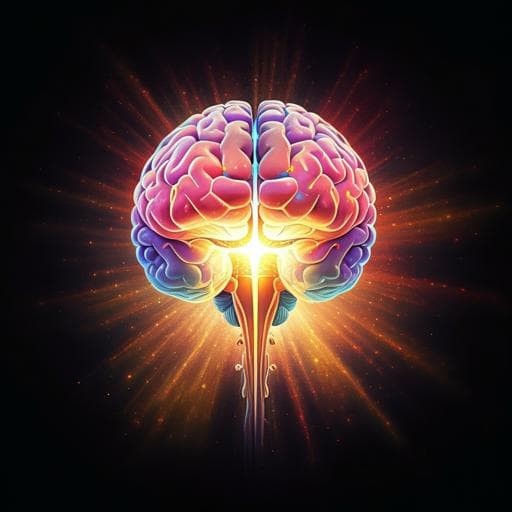
Psychology
Cognitive representations of intracranial self-stimulation of midbrain dopamine neurons depend on stimulation frequency
S. J. Millard, I. B. Hoang, et al.
This exciting study by Samuel J. Millard and colleagues delves into the fascinating world of intracranial self-stimulation (ICSS) of midbrain dopamine neurons, revealing how different stimulation frequencies affect reward motivation! Discover how a physiological prediction error at 20 Hz contrasts sharply with the robust motivational effects of 50 Hz stimulation on behavior.
~3 min • Beginner • English
Introduction
Phasic firing of VTA dopamine neurons signals prediction errors during learning, typically at 10–20 Hz for brief periods, and has been linked to forming cognitive maps and associative learning rather than solely conveying scalar value. Despite this, animals readily perform ICSS for phasic dopamine stimulation, suggesting that under some conditions dopamine signaling may be experienced as rewarding. The study asks: what cognitive representation underlies ICSS driven by dopamine neuron stimulation, and does this depend on stimulation frequency? Using Pavlovian-to-instrumental transfer (PIT) to dissociate general value from sensory-specific reward representations, the authors compare dopamine stimulation as an outcome to a food reward and test whether physiological (20 Hz) versus supraphysiological (50 Hz) stimulation frequencies differentially support learning, motivation, and cue-evoked transfer.
Literature Review
Prior work established dopamine prediction errors (Schultz et al., 1997) and phasic VTA activity during reward processing (Roesch et al., 2007). Dopamine transients can support model-based associations and reward identity predictions, indicating roles beyond scalar value. ICSS of midbrain regions has long been demonstrated, with typical studies employing high-frequency stimulation that robustly supports self-stimulation. PIT paradigms in rodents and humans distinguish general motivational effects from sensory-specific incentive processes. Studies also show mesolimbic dopamine release tracking reinforcement expectation and that high-frequency stimulation engages error-like regulation similar to natural rewards. However, few studies have probed the cognitive representation of dopamine ICSS, and whether physiological versus supraphysiological frequencies differentially impact reinforcement and cue value remains unresolved.
Methodology
Subjects: Male and female Long-Evans rats, including TH-Cre transgenics. Optogenetics: Cre-dependent AAV5-EF1α-DIO-ChR2-eYFP injected bilaterally into VTA; optic fibers implanted bilaterally. Dopamine neuron stimulation via 473 nm light, 1 s trains at 20 Hz or 50 Hz (5-ms pulses, ~14–16 mW). Pavlovian conditioning: Two auditory cues each paired with an outcome (sucrose pellets or VTA stimulation; counterbalanced), 10 days, four 2-min cue presentations per session with pseudorandom reward deliveries during cues. Instrumental training: Separate lever for each outcome, progressing from FR1 to RR5 to RR10; each lever available in 10-min blocks with up to 40 outcomes per session. PIT test: Both levers available; no outcomes delivered; cues presented to assess selective versus general PIT after 8 min extinction, across three sessions. Blocking experiment (positive control for 20 Hz): Two visual cues each predicting distinct rewards (acquisition); then audiovisual compounds predicting same rewards (blocking), with 20-Hz stimulation coincident with one reward delivery to mimic a prediction error; subsequent probe tests with auditory cues alone; outcome-specific devaluation using LiCl of the reward associated with the unblocked (stimulation-paired) cue. ICSS assay (in blocking cohort): Access to an active lever delivering 1 s 50-Hz VTA stimulation versus an inactive lever on continuous reinforcement during a 30-min session. Electrophysiology: TH-Cre rats received VTA ChR2 expression and a 16-channel microwire array with central optic fiber for simultaneous photo-stimulation and single-unit recordings to compare fidelity, firing rate, spike probabilities across the train, and latency to the 10th spike for 20 vs 50 Hz. Fiber photometry: GRABDA sensor expressed in NAc medial core; simultaneous VTA stimulation (20 or 50 Hz) and dopamine fluorescence recording; sessions including food pellet delivery to compare NAc dopamine transients; AUC and waveform analyses with bootstrapped CIs and permutation tests. Statistics: Mixed-design repeated-measures ANOVAs, planned simple effects, one-tailed tests for directional hypotheses; Pearson correlations for ICSS-unblocking relationship; linear mixed-effects models for photometry AUC.
Key Findings
- Pavlovian phase: Locomotor activity increased across sessions for both cues (session F4,36=68.595, P<0.0001) without differences between dopamine- vs food-paired cues (F1,9=0.075, P=0.790) or between 20 vs 50 Hz groups (F1,9=0.482, P=0.505). Food-port entries increased only for the food-paired cue (cue F1,9=13.221, P=0.005), with significant session and session×cue effects; no group interactions.
- Instrumental training: 20-Hz group responded for dopamine only under FR1 and failed to maintain robust responding on leaner schedules, whereas 50-Hz group showed robust responding for both dopamine stimulation and food as effort increased. ANOVA: main effect of reward (F1,9=21.528, P=0.001), reward×group interaction (F1,9=21.544, P=0.001); significant group difference for dopamine responding (F1,9=30.738, P=0.000), not for food (F1,9=0.128, P=0.729); session main effect (F7,43=149.418, P=0.000) and session×group interaction (F7,43=9.413, P=0.000); overall between-group difference (F1,9=15.647, P=0.003).
- PIT test: 20-Hz group showed selective PIT only for the food-paired cue; dopamine-paired cue did not increase responding. Cue×lever interaction (F1,5=15.383, P=0.011); selective increase for food cue (same vs different lever F1,5=13.957, P=0.013); no selective effect for dopamine cue (F1,5=3.759, P=0.110); responding on same lever higher for food than dopamine cue (F1,5=7.885, P=0.038). 50-Hz group showed robust selective PIT for both cues: main effect of lever (F1,4=20.193, P=0.011); no cue main effect (F1,4=0.585, P=0.487) or interaction (F1,4=0.505, P=0.516).
- Positive control (blocking) for 20 Hz: During blocking, stimulation did not disrupt responding to predictive visual cues. Probe test showed greater responding to the stimulation-paired (unblocked) auditory cue vs control (F1,8=3.614, P=0.047). Outcome devaluation reduced responding to the unblocked cue (group F2,7=5.15, P=0.029), confirming sensory-specific learning; no effect for the blocked cue (Supplementary, F2,7=0.157, P=0.352).
- ICSS (50 Hz) in blocking cohort: Rats pressed more on active vs inactive lever (F1,8=10.42, P=0.006). Unblocking magnitude positively correlated with ICSS responding (Pearson r=0.596, R2=0.355, P=0.045); no correlation for blocked cue (r=0.148, R2=0.022, P=0.352).
- Electrophysiology: Spike fidelity to pulses higher for 20 Hz vs 50 Hz (F1,6=12.38, P=0.013), but total action potentials across the 1-s train did not differ significantly between 20 and 50 Hz. Spike probability similar for first five pulses (F=4.7, P=0.074) but differed for last five pulses (F=11.61, P=0.014). Latency to tenth spike shorter for 50 Hz (F1,6=7.983, P=0.03), indicating earlier burst firing.
- Fiber photometry (NAc): 50-Hz stimulation produced greater dopamine release than 20 Hz (AUC t=2.47, P=0.017). Food delivery evoked prolonged dopamine increases; both 20- and 50-Hz trains increased dopamine above baseline for shorter durations. Permutation tests showed significant difference between food and 20 Hz, but not between food and 50 Hz, in magnitude. Overall, 50 Hz yielded higher and more ICSS-like dopamine release than 20 Hz.
Discussion
Physiologically relevant 20-Hz VTA dopamine stimulation reproduces a teaching signal sufficient to support sensory-specific associative learning (unblocking) but does not act as a robust primary reward: it fails to sustain instrumental responding beyond continuous reinforcement and does not endow cues with general motivational value in PIT. In contrast, the supraphysiological 50-Hz stimulation functions as a specific sensory reward that supports vigorous ICSS and selective PIT comparable to food. Electrophysiology shows both frequencies generate similar numbers of spikes but with different temporal concentration: 50 Hz compresses spikes into a shorter interval (greater burst-like firing early), leading to stronger downstream dopamine release in NAc, aligning with its greater reinforcing efficacy. Photometry indicates that natural food evokes more prolonged dopamine release than either stimulation, but the magnitude of 50-Hz-evoked release approaches food more closely than 20 Hz. These findings dissociate dopamine prediction-error signaling from reward value per se and indicate that high-frequency stimulation creates a specific sensory event outside normal experiential representations. They further suggest that interpretations of dopamine ICSS at high frequencies should not be generalized to the role of physiological prediction errors in everyday reinforcement learning. Implications for addiction are that drug seeking may reflect pursuit of a specific sensory experience linked to enhanced dopaminergic activity rather than generalized cue-driven value increases.
Conclusion
The study demonstrates a frequency-dependent dichotomy in the cognitive representation of VTA dopamine neuron stimulation: 20 Hz acts as a teaching signal that supports sensory-specific associative learning but lacks reinforcing value sufficient for robust ICSS or PIT, whereas 50 Hz creates a supraphysiological, sensory-specific reward that supports strong ICSS and selective PIT. Mechanistically, differences arise from spike timing and burst concentration, producing greater NAc dopamine release at 50 Hz despite similar spike counts. These results clarify that high-frequency dopamine ICSS does not model physiological prediction-error value coding. Future work could identify naturalistic or pathological states that transiently elevate dopaminergic firing to ICSS-like regimes, delineate circuit-level modulators in NAc and upstream regions shaping dopamine release dynamics, and probe how drugs of abuse may emulate high-frequency dopaminergic sensory experiences.
Limitations
- Some recording and photometry sample sizes were small (e.g., electrophysiology n=7 cells; photometry n=3 rats), and certain analyses (e.g., waveform comparisons) were not replicated within the study, though similar to prior reports.
- Behavioral effects were assessed in rats; generalization to other species or contexts requires caution.
- Analyses assumed normality; homoscedasticity was not formally tested; data collection and analysis were not blinded.
- PIT and ICSS used specific schedules and parameters (e.g., 1-s trains, fixed powers); different temporal patterns or intensities might yield different outcomes.
- Equal contribution designation (superscript 6) is not an affiliation; potential subtle variability in viral expression and fiber placements may impact effect sizes.
- Photometry suggests food-evoked dopamine differs in duration and sometimes magnitude from stimulation; more granular mapping of release dynamics across subregions was limited.
Related Publications
Explore these studies to deepen your understanding of the subject.







